The most predictable administration
December 7, 2020
The contrast between 2016 and 2020 could not be more stark.
At this time four years ago, then President-elect Donald Trump was forming his administration, coming in as a Washington outsider who had never served in the military or held public office.
From his penthouse at Trump Tower, Trump made many selections that at best stunned and at worst perplexed many of the Washington elite: choosing oil executive Rex Tillerson as secretary of state, tapping provocative former general Michael Flynn as national security adviser, picking former surgeon Ben Carson to head the Department of Housing & Urban Development and selecting Betsy DeVos as secretary of education.
Trump also rattled many by picking daughter Ivanka Trump and son-in-law Jared Kushner to be senior advisers, while also hiring former campaign manager Kellyanne Conway as a presidential counselor, in addition to choosing controversial campaign aide Steve Bannon to be chief strategist. Trump’s picks strongly correlated with his message to disrupt “usual” politics with something new, to create change.
These staffing and personnel moves, which were made while the transition was fraught with internal divisions and power struggles, left the new administration severely weakened as it prepared to assume the duties and responsibilities that come with governing.
However in 2020, the opposite has shown itself early on.
President-elect Joe Biden is forming a new administration with the advantage of being a longtime Beltway veteran; he was elected as one of Delaware’s two senators in 1972 at the age of 29, served in the Senate for 35 years, was vice president for eight years and now comes in as the oldest president to be elected, at age 78.
From his home in tiny Wilmington, Del., Biden is forming what could be summed up as the most predictable administration of all time, choosing a group of Washington careerists to form his new administration.
His senior White House staff will feature longtime Democratic power player Ron Klain as White House chief of staff, Mike Donilon and Rep. Cedric Richmond as senior advisers, Steve Ricchetti as counselor and a press team made up of Democratic party operatives and Obama administration alumni such as Jen Psaki as press secretary and Kate Bedingfield as director of communications.
While the full cabinet hasn’t been announced yet, so far the national security and economic teams are a who’s who of longtime Biden loyalists, Washington insiders and Obama administration alumni: national security official Antony Blinken will be secretary of state, longtime Biden aide Jake Sullivan will serve as national security adviser, Obama administration official Avril Haines will take on the role of director of national intelligence and Linda Thomas-Greenfield, a former foreign service director, will represent the United States at the United Nations as ambassador.
So far the big name on the economic team is Janet Yellen, the former chair of the Federal Reserve who will serve as treasury secretary. Other names as part of that economic team are Cecilia Rouse, who will chair the Council of Economic Advisers, and Neera Tanden, who will be director of the Office of Management and Budget.
All of that is to say that the contrast that comes with administration forming could not be more different. Trump approached the transition and his impending presidency with a bit of swagger that included making unconventional hires and putting his family in his inner circle to help formulate an agenda and policy goals.
On the other hand, Biden has approached the transition predictably and cautiously, looking to hire people that, in his words, reflect America – people he knows well and are “simpatico” with him, all the while towing the line between what would suit his moderate instincts while also attempting to either placate or outright shun the progressive elements of his party.
In other words, Biden has so far made it his priority to hire people whom he knows, who have a truckload of Washington experience, and who he believes will restore stability and a conventional approach to their respective positions.
In many ways, this is the predictable administration outlook Biden promised voters during the campaign. Unlike Trump, Biden picked individuals based on a change in voters’ desires – four years dedicated to returning to politics as usual. While some of these picks, notably Tanden, have aggravated the left flank of the Democratic party, most across the political spectrum have heralded these picks as acceptable to all camps, including the camps of some Republicans.
It has yet to be seen if Biden will maintain the pattern of hiring predictable — some would say boring — Washington insider-type people, but one thing can be said without a doubt: the approaches to personnel picking and governing exhibited by the outgoing president and the incoming president could not be more divergent.
MICHAEL GUIDO




